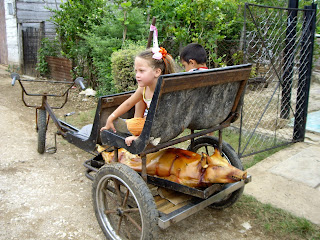
Macaroons




 Students hitch hiking.
Students hitch hiking. Cuban scenary.
Cuban scenary.




 Custard-apple fruit ( chirimoya)
Custard-apple fruit ( chirimoya)

I do not know if every Cuban shares my enthusiasm for mangos but I know my brother does. To me this is the top fruit pick and I really miss them when the ripening season is too far away to wait. I also dream of making quick trips to Singapore or Hong Kong to catch up with their mango seasons there.
In Cuba it seems like we cannot wait either because children start eating them unripe. I was surprised it is completely normal to find unripe mangos in Asian dishes as a salad ingredient.
Recently I was so happy to get a box of Kensington Pride frozen mango cheeks. I feel so smart; imagine having tasty mangos when they are out of season.
I wondered why Australia offers other fruits like avocado, strawberries or pineapples year round but not my heavenly Kensington Pride mangoes. But anyway I smile thinking that if I did have them so often I would not put them on top of my list. I patiently wait for the season to start when summer arrives in the north.
This week I am over the moon with my box of frozen mangos, ah like a child with a box full of candy. Of course I have to do something special with it, I found in a book a recipe I want to try, called mango fool, it should go well with blueberries.
2 mangos or equivalent (5cheeks)
200 ml pouring cream
½ cup sugar or less
1. You must thaw the mangos and then put them in a food processor with the steel blade and puree them.
2. Mix mango and sugar and put away until needed again.
3. Whip your pouring cream.
4. Fold the cream into the mango and pour in mould to refrigerate. Cover for 2 hours.
A simpler version is to fold the mango puree in natural yogurt, something you can serve at breakfast straight away.
You can try also to make a delicious milkshake. Just after you have puree the mango in the food processor, put it in the blender with a cup of milk, a tablespoon of condensed milk and some ice cubes.


 Country side.
Country side.  Tamal.
Tamal. Making tamal from fresh corn.
Making tamal from fresh corn. Mamey fruit.
Mamey fruit. Country side, Cuba.
Country side, Cuba. Cuban family picking fruit.
Cuban family picking fruit. Cubans drinking guarapo, a refreshing drink made from sugar cane.
Cubans drinking guarapo, a refreshing drink made from sugar cane.  This is a common way of traveling.
This is a common way of traveling.
 Roast suckling pig in Cuba
Roast suckling pig in Cuba 




